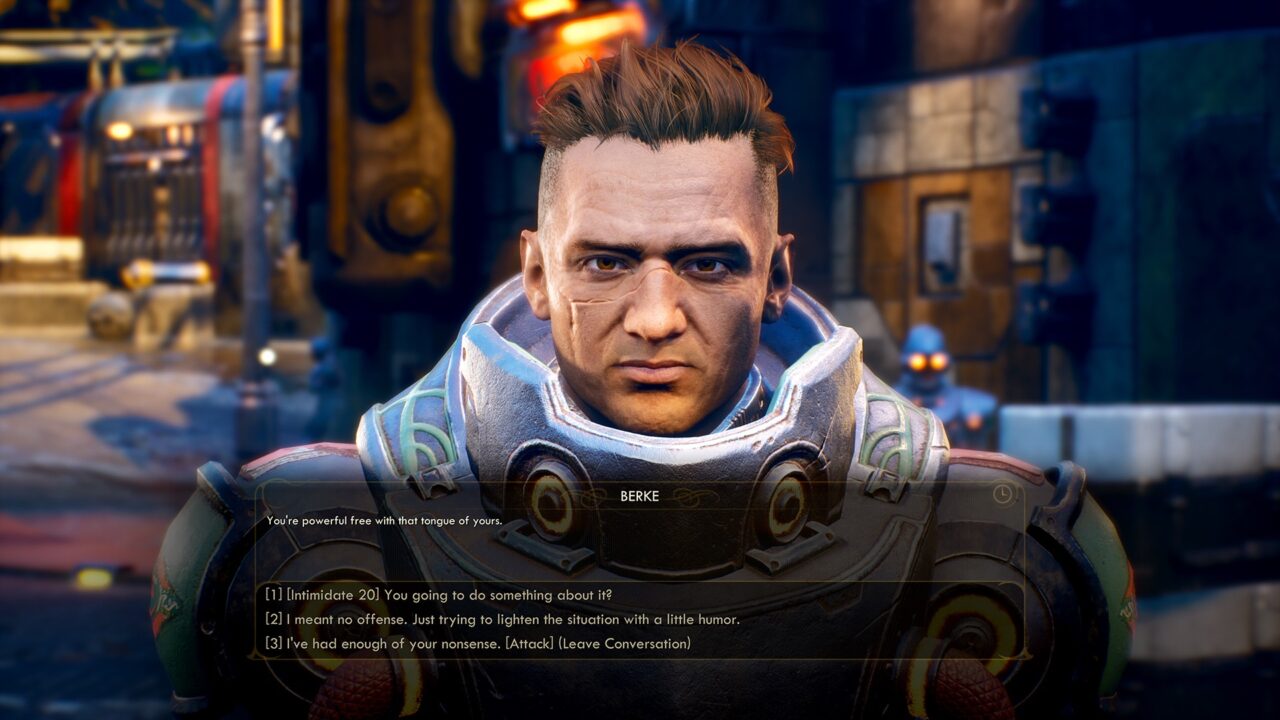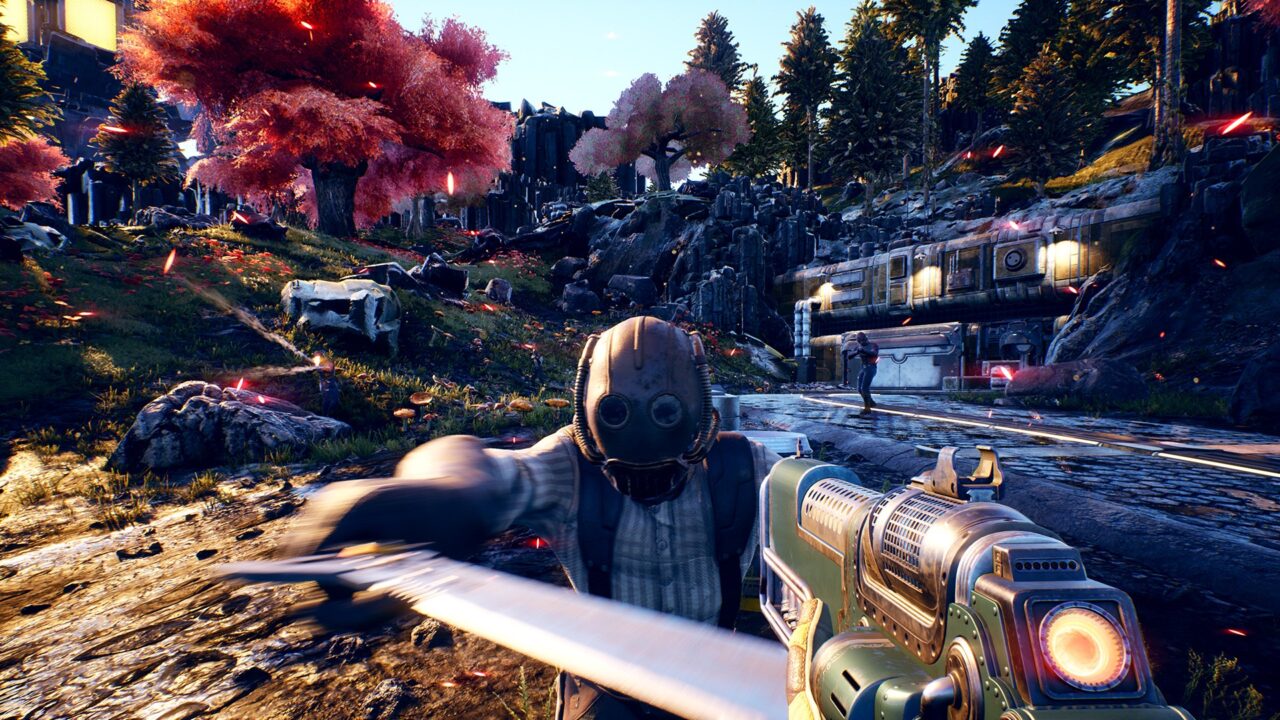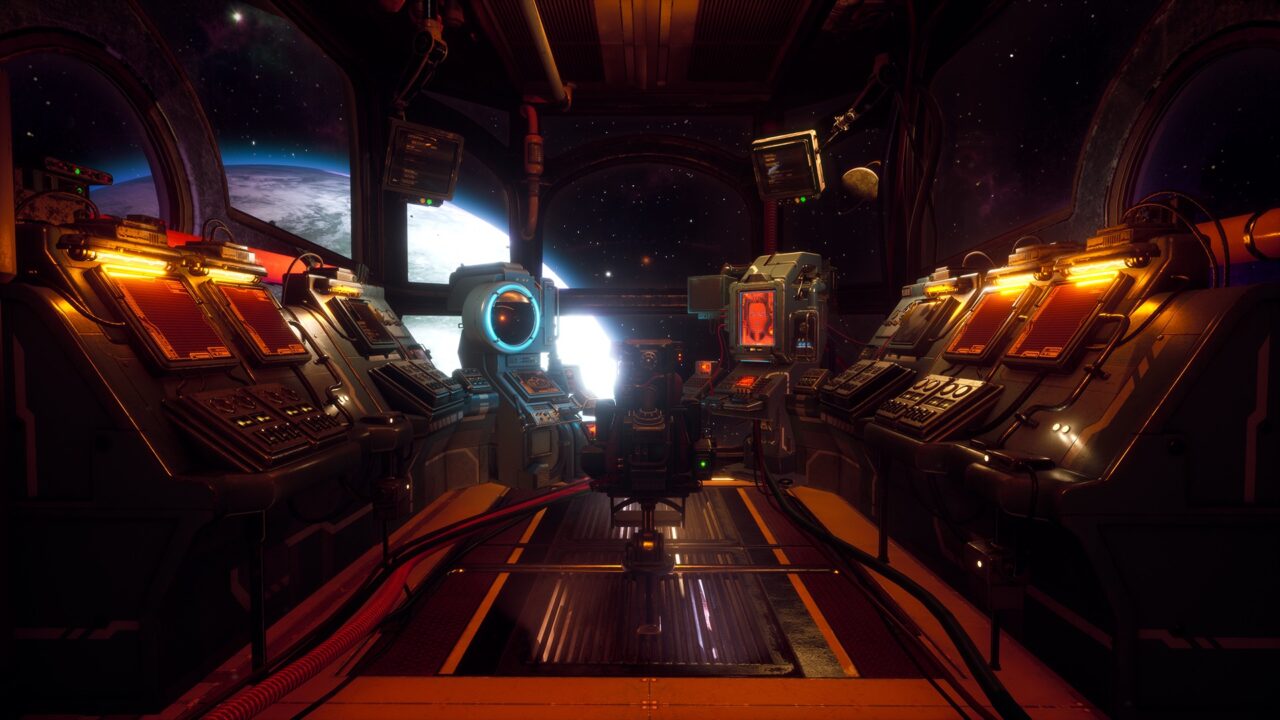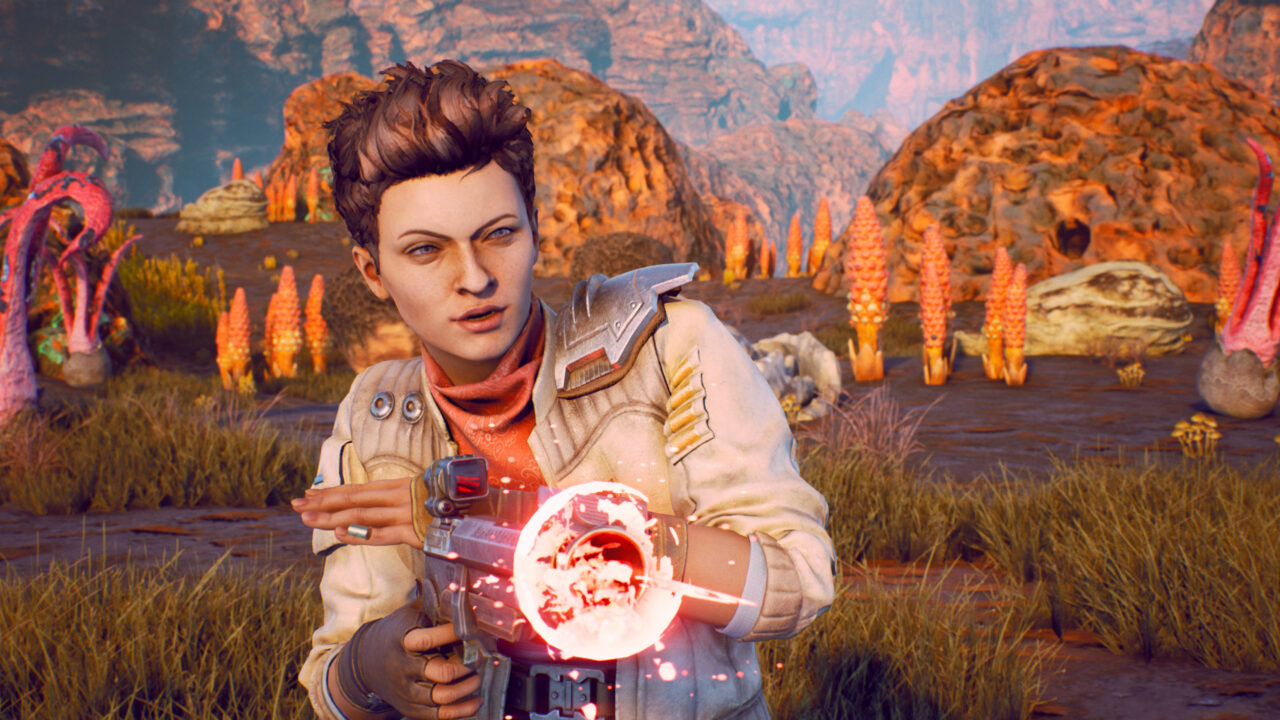Scroll down to see a video review of The Outer Worlds.
Spiritual sequels can be risky bets for developers. It boils down to two questions: Did fans of the original work love the original for the story and characters? Or was it the mechanics and overall tone? The team at Obsidian Entertainment decided to take that bet and created a spiritual successor to one of their most popular and acclaimed RPGs, Fallout: New Vegas. Did it pan out for them? Well, let’s put it this way: If they were in New Vegas, they would have hit the jackpot.
In The Outer Worlds, you play as a survivor of a colony ship lost for 70 years. Rescued from cryosleep by Phineas Welles (think a slightly more criminal Doc Brown looking for his Marty), you are set loose on an unsuspecting colony run entirely by “The Board,” a group of robber baron corporations. Do you hunt down the chemicals that will allow Welles to thaw the rest of the lost colonists? Do you put that on the backburner to side with the Halcyon colony’s insurgents, who are struggling to be free of the corporatocracy? Or do you become a corporate shill, slapping down dissidents with an iron fist and a catchy jingle? The choice is yours!
And that’s where The Outer Worlds absolutely shines: choice. Obsidian Entertainment are masters of creating multilayer RPGs where your every incidental decision can have far-reaching consequences. The big choices you’re faced with are not easy, and there is rarely an option that leaves everyone happy. You are often put into no-win scenarios where people will suffer, no matter what you decide. Your choices simply determine who comes out on top. After making the first big decision in the game, I lay in bed later that night, wondering if there was a way I could rescue everyone if I reloaded an old save. I had to get used to making life-or-death calls because there were many more on the horizon as I flew off into the wider Halcyon solar system.

It’s impossible to talk about The Outer Worlds without mentioning Fallout: New Vegas. When Bethesda reached out to Obsidian to create a spinoff to their own Fallout 3, they couldn’t have anticipated that it would eventually eclipse their own efforts in both scope and esteem. New Vegas soon became a shining example of freedom of choice in first-person RPGs. You could finish the game in your own way, either shooting everyone on sight or convincing them to take your side with a mix of logic, charisma, and threats. Instead of interacting with a traditional morality system, you built relationships with factions throughout the world — some good, some bad. This system returns in full force in The Outer Worlds, expanded with even deeper levels of interaction. The relationships you develop with the various corporations, insurgents, and independent factions will determine how the dramatic story of the Halcyon colony unfolds.
In fact, many staples of the Fallout series are used to significant effect here. That makes sense, as two of the creators of the original Fallout, Tim Cain and Leonard Boyarsky, are the directors of The Outer Worlds. There are doors to break into, terminals to hack, and pockets to pick. A system similar to VATS called Tactical Time Dilation allows your character to slow down time and target specific body parts of enemies (without the auto-aiming of VATS). The exceptional environmental storytelling that is a hallmark of Fallout is also used here, with abandoned colonies and tragic short stories littering the landscape. The only issue is the lack of audio logs. While the last iteration of Fallout, Fallout 76, relied too much on them to tell its story, The Outer Worlds could have benefited from having voice acting for some of the text-only “audio transcripts” on terminals. They may have been kept silent for budgetary reasons, but it’s missed opportunity nevertheless.

Also on display is an evolution of Fallout’s apocalyptic satire, updated for the 21st century. The entire Halcyon system is a rotting eutopia, with life being choked by corporate ideology at every turn. To the Board, a citizen is the same as an employee. Every company is distinct, with its own sense of style and design. Each is governed by its own corporate ethos and driven by a sense of corporate patriotism. It’s as if ten companies like Fallout’s Vault-Tec banded together and were given their own solar system to play with. The satire on consumerism and corporate ideology never feels overstated. In fact, the jingoistic marketing of these organizations makes this world feel all the more plausible (with strong parallels to our own). Like the best of Fallout, this satire is both on point and pitch black, leading to some very funny and dark moments throughout. A poor cashier permanently stuck inside a corporate mascot costume comes to mind.
Obsidian proudly proclaims that The Outer Worlds is a AA (rather than a AAA) game. This puts the budget somewhere between an indie game and massive open-world RPGs like The Witcher 3. There isn’t a single, seamless world that you can traverse from one side to the other at will. Instead, it features several expansive maps that beg you to explore them. Your quest log will soon become packed, with markers spread out over several different locations in the Halcyon system that you can travel to using your spaceship, the Unreliable.
Frankly, if Obsidian wasn’t pulling inspiration from cult-favorite TV show Firefly, I’d be stunned. Within the first few hours, I had a dilapidated ship that looked strikingly like a boxy version of Serenity. My crew consisted of an adorably awkward and brilliant engineer and a holy man with a hidden violent streak. And every time I arrived in a town, I’d hear the sounds of acoustic guitars in the background. For the first third of the game, The Outer Worlds feels like a frontier western, just like Firefly. After you leave the opening area, Edgewater, everything takes on its own flavor. During the first section, however, I genuinely wondered if Obsidian had been hired to create a Firefly RPG and lost the license soon after development started.

Even though The Outer Worlds doesn’t quite have the same vast lands as New Vegas, it still offers a truly intimidating number of gameplay and story choices. I barely even scratched the surface in my first playthrough. My sniper with a silver tongue and heart of gold took the path of the angels, but I certainly didn’t have to. I could have betrayed Phineas Welles the first chance I got and tried to take over the entire colony for myself. Even at the end of the game, the choices I made in the first hour came back to haunt and hinder me. The Outer Worlds might not offer as massive a world as New Vegas, but its scope is considerably larger. You could play this game dozens of times and never have the same experience. A single run can take about a week, but the replay value here is off the charts.
The gameplay is, as you might expect, a solid entry in the first-person RPG genre. There is no shortage of weapons, armor, and items that you can loot or purchase (all delightfully branded by the corporations of Halcyon with helpful and hilarious marketing copy attached in the inventory screen). You can also find special “science weapons” hidden around the Halcyon colony. These range from shrink rays to mind control guns. They might not seem as viable as your usual sidearm, but when confronted with a massive alien beast trying to chow down on you and your companions, having a shrink ray can come in handy!
Speaking of your companions, they are a key component of combat. You can choose their default stance (aggressive, passive, or defensive), but my advice is to take them off aggressive as soon as possible, especially if you plan on any measure of stealth. When set to aggressive, the slightest provocation has them rocketing into battle, with or without you. Once in combat, you can quickly select which enemies they should engage using their regular or special attacks. If you aim at an enemy and pick a companion’s special move, they launch themselves at said foe with attacks that have effects and buffs which can dramatically turn the tide of a fight. These attacks come with their own cutscenes, which are thankfully short enough that they don’t become too annoying. Your companions also level up with you, providing key stats and abilities you might lack depending on your character build. Don’t have a head for medicine? Take Ellie, the freelance surgeon/gunhand with you!

Unfortunately, the AI for both your companions and enemies isn’t exactly groundbreaking. In fact, it’s fairly easy to elude enemies by standing on a platform out of their reach or simply closing the door and waiting. Having a guard discover a dead body, then return to their patrol route after 30 seconds of searching is something that we should be beyond by now in terms of gameplay.
The Outer Worlds isn’t likely to win any awards for its graphics, but it certainly should for its design. Each alien world feels distinct, with its own flora and fauna (including lots of imaginative monsters with big teeth trying to eat you). Loading screens present anatomy charts that are hand-drawn in a 19th-century style, displaying each animal’s skeletal structure, internal organs, and reproductive cycles. This makes them feel like “real” creatures discovered and dissected by pioneering naturalists.
While the music didn’t blow me away (it’s well written, with nothing overly memorable), the voice acting did. On the whole, characters shine with personality and depth, with only an occasional awkward performance. Your companions are delightful, and no one feels redundant. I was especially fond of ADA, your ship’s possibly sentient nav-computer. Her snarky comments every time I reentered the ship, along with her barely restrained contempt for your crew, never failed to make me smile. Your ace engineer, Parvati Holcomb, is one of the most adorable characters I’ve ever come across, and her wide-eyed wonder and gigantic hammer almost always made her a welcome member of my party. Companions aren’t romanceable, but there is still lots of room for character growth, as each one has a lengthy side quest to unlock hidden perks. Moreover, the decisions you make during these side quests shape their personalities and loyalty to you and your crew. Yet more choices in a game that’s loaded with them!
Going into The Outer Worlds, I was concerned about bugs. Fallout: New Vegas is still notorious for being one of the buggiest AAA games in history, and Fallout games since then haven’t fared much better (looking at you, 76). I was amazed to discover that The Outer Worlds was remarkably stable during my playthrough. At no point did I fall through the world, there were no game crashes, quest givers who were supposed to be alive were miraculously always alive, and bizarre physics bugs that send NPCs flying miles away after shooting them simply didn’t happen. The game was… stable. It was a lovely change from what I routinely expect from the developer of its spiritual predecessor.
The Outer Worlds is a triumph for Obsidian Entertainment and AA games in general. They set out to create a successor to New Vegas and succeeded on every conceivable level. Every mechanic I loved from that game, including the stunningly robust faction system, has been taken to new heights. Sure, the world isn’t quite as big as New Vegas, but with the almost-limitless choices the game offers you, it feels just as massive. The Outer Worlds may not reinvent the genre, but it is an outstanding example of how engaging RPGs can be when created by developers who have a passion for them and video games in general!



